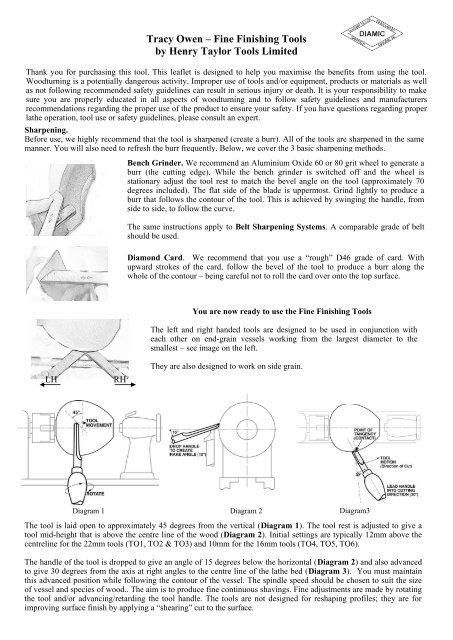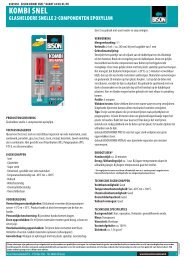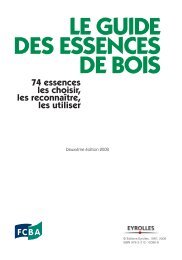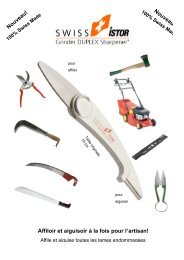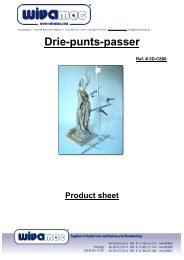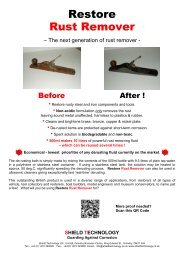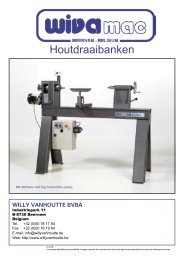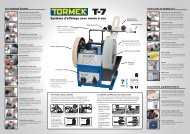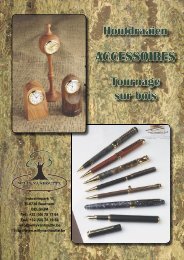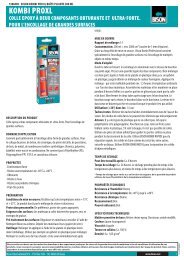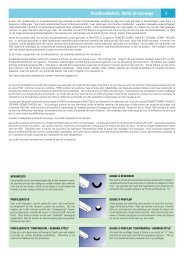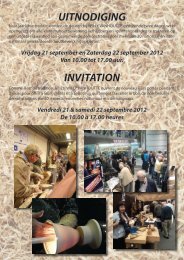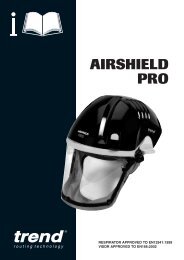Tracy Owen – Fine Finishing Tools by Henry Taylor Tools Limited
Tracy Owen – Fine Finishing Tools by Henry Taylor Tools Limited
Tracy Owen – Fine Finishing Tools by Henry Taylor Tools Limited
- No tags were found...
You also want an ePaper? Increase the reach of your titles
YUMPU automatically turns print PDFs into web optimized ePapers that Google loves.
<strong>Tracy</strong> <strong>Owen</strong> – <strong>Fine</strong> <strong>Finishing</strong> <strong>Tools</strong><br />
<strong>by</strong> <strong>Henry</strong> <strong>Taylor</strong> <strong>Tools</strong> <strong>Limited</strong><br />
Thank you for purchasing this tool. This leaflet is designed to help you maximise the benefits from using the tool.<br />
Woodturning is a potentially dangerous activity. Improper use of tools and/or equipment, products or materials as well<br />
as not following recommended safety guidelines can result in serious injury or death. It is your responsibility to make<br />
sure you are properly educated in all aspects of woodturning and to follow safety guidelines and manufacturers<br />
recommendations regarding the proper use of the product to ensure your safety. If you have questions regarding proper<br />
lathe operation, tool use or safety guidelines, please consult an expert.<br />
Sharpening.<br />
Before use, we highly recommend that the tool is sharpened (create a burr). All of the tools are sharpened in the same<br />
manner. You will also need to refresh the burr frequently. Below, we cover the 3 basic sharpening methods.<br />
Bench Grinder. We recommend an Aluminium Oxide 60 or 80 grit wheel to generate a<br />
burr (the cutting edge). While the bench grinder is switched off and the wheel is<br />
stationary adjust the tool rest to match the bevel angle on the tool (approximately 70<br />
degrees included). The flat side of the blade is uppermost. Grind lightly to produce a<br />
burr that follows the contour of the tool. This is achieved <strong>by</strong> swinging the handle, from<br />
side to side, to follow the curve.<br />
The same instructions apply to Belt Sharpening Systems. A comparable grade of belt<br />
should be used.<br />
Diamond Card. We recommend that you use a “rough” D46 grade of card. With<br />
upward strokes of the card, follow the bevel of the tool to produce a burr along the<br />
whole of the contour – being careful not to roll the card over onto the top surface.<br />
You are now ready to use the <strong>Fine</strong> <strong>Finishing</strong> <strong>Tools</strong><br />
The left and right handed tools are designed to be used in conjunction with<br />
each other on end-grain vessels working from the largest diameter to the<br />
smallest – see image on the left.<br />
LH<br />
RH<br />
They are also designed to work on side grain.<br />
Diagram 1 Diagram 2 Diagram3<br />
The tool is laid open to approximately 45 degrees from the vertical (Diagram 1). The tool rest is adjusted to give a<br />
tool mid-height that is above the centre line of the wood (Diagram 2). Initial settings are typically 12mm above the<br />
centreline for the 22mm tools (TO1, TO2 & TO3) and 10mm for the 16mm tools (TO4, TO5, TO6).<br />
The handle of the tool is dropped to give an angle of 15 degrees below the horizontal (Diagram 2) and also advanced<br />
to give 30 degrees from the axis at right angles to the centre line of the lathe bed (Diagram 3). You must maintain<br />
this advanced position while following the contour of the vessel. The spindle speed should be chosen to suit the size<br />
of vessel and species of wood.. The aim is to produce fine continuous shavings. <strong>Fine</strong> adjustments are made <strong>by</strong> rotating<br />
the tool and/or advancing/retarding the tool handle. The tools are not designed for reshaping profiles; they are for<br />
improving surface finish <strong>by</strong> applying a “shearing” cut to the surface.
<strong>Finishing</strong> the inside of a bowl or vessel using the<br />
round finishing tool.<br />
The basic set up for the round finishing tool is exactly<br />
the same as for the left & right hand tools. However,<br />
the tool can be used in both directions – both cutting<br />
towards and away from the centre. It is important to<br />
note that the tool must be on the centreline when<br />
approaching the centre of the bowl or vessel, which<br />
may require the tool height to be adjusted.<br />
<strong>Finishing</strong> Convex, Concave and Rim Surfaces.<br />
You will be able to judge yourself, which of the three tool forms works best for a specific form; it may be a combination of<br />
the left & right-hand tool or the round <strong>Fine</strong> <strong>Finishing</strong> Tool. Simply follow the instructions for generating the burr and the<br />
general set-up instructions<br />
Using the Box tool.<br />
A versatile tool for both hollowing and finishing.<br />
The tool is sharpened on the front face <strong>by</strong> exactly the same method as all<br />
the other tools.<br />
Hollowing: To hollow a form you should have the top edge of the tool on<br />
the centre line of the wood. The tool should be horizontal and pushed<br />
(without excessive force) into the wood. This process should be repeated<br />
until you have achieved the correct depth and internal diameter.<br />
<strong>Finishing</strong>: to apply an excellent finish to the bottom of the box, refresh the<br />
burr and, with the tool handle slightly raised, traverse across the bottom of<br />
the box.<br />
You can view <strong>Tracy</strong> using the tools on YouTube - just logon and search under<br />
<strong>Tracy</strong> <strong>Owen</strong> or follow the link on our website www.henrytaylortools.co.uk.<br />
You can see more of <strong>Tracy</strong>’s work on www.tracyowen.com.<br />
Enjoy !<br />
Our tools are made in Sheffield (UK) <strong>by</strong> our own craftsmen who have<br />
many years of experience in hand tool manufacturing.<br />
<strong>Henry</strong> <strong>Taylor</strong> (<strong>Tools</strong>) <strong>Limited</strong>,<br />
Peacock Estate, Livesey Street, Sheffield, S6 SBL, UK<br />
Tel +44 (0) 114 234 0282 Fax +44 (0) 114 285 2015<br />
Email sales@henrytaylortools.co.uk<br />
Website: www.henrytaylortools.co.uk<br />
Established 1834<br />
Issue 4 August 2010


